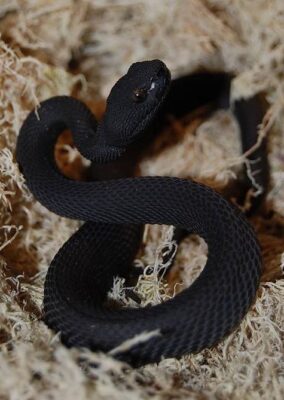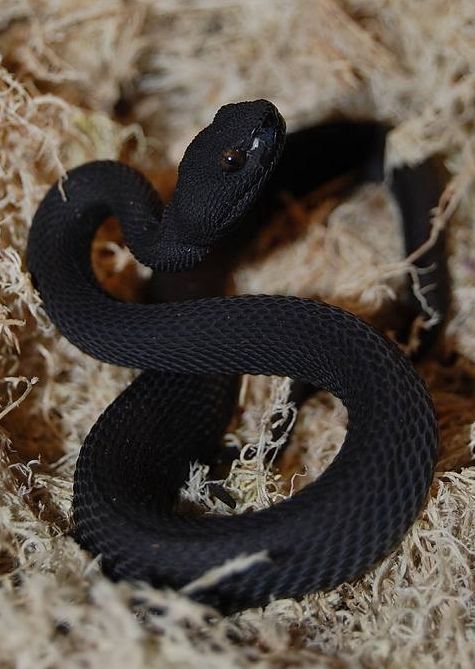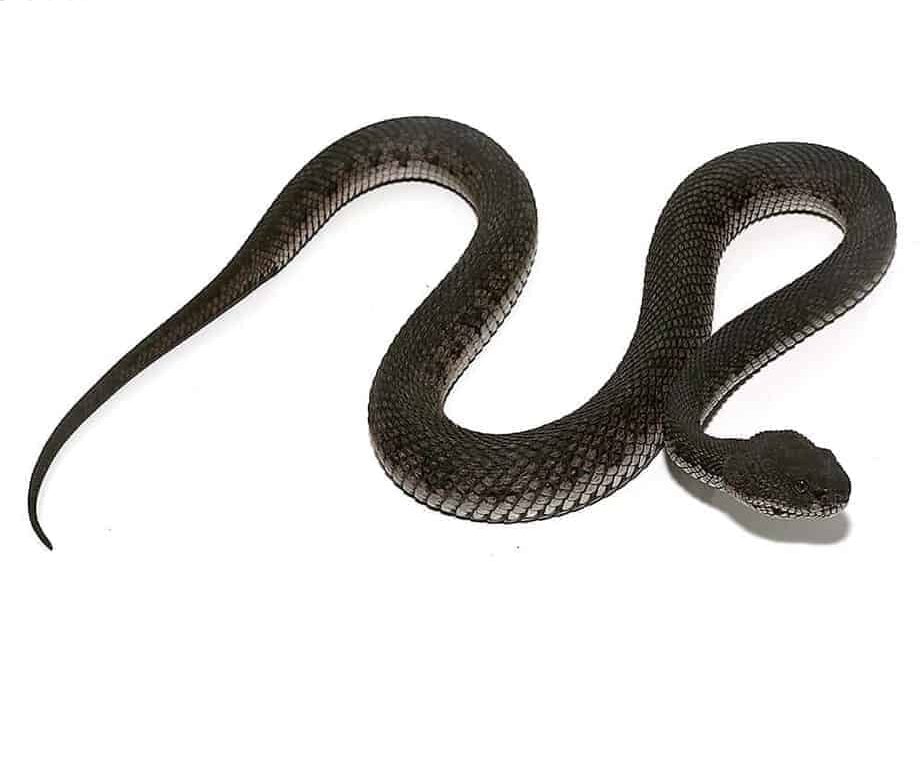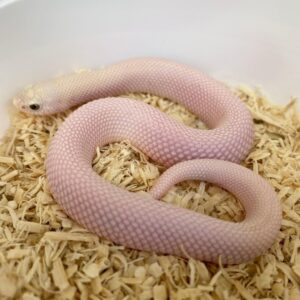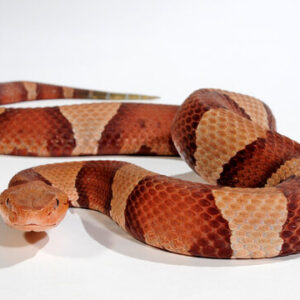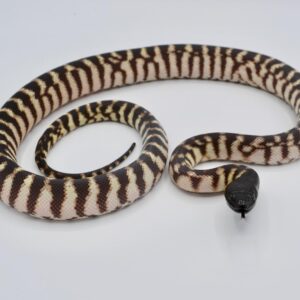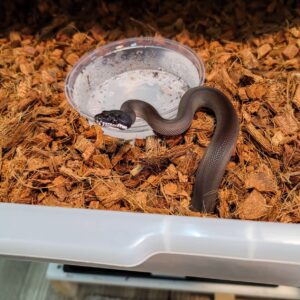Black Purple Spotted Pit Viper For Sale
$699.99
Black Purple Spotted Pit Viper FOR SALE. HERE ARE SOME HIGHLIGHTS:
- Trimeresurus purpureomaculatus
- Field Collected
- Approximately 16 – 24 Inches In Length
- Feeding On Frozen Thawed Or Live Hopper Mice
- *These Are Venomous. Please Know Your State Laws Before Inquiring As Some States Require Venomous Permits*
FUN FACTS!
- Tropical Species Requiring Temperatures From The Low 80s To Low 90s And Daily Misting
- Highly Arboreal So Be Sure To Provide A Taller Setup With Plenty Of Branches For Climbing And Perching
- This Is An Obscure Species With Not Much Field Info Listed On Them
Description
The Black Purple Spotted Pit Viper, scientifically known as Trimeresurus purpureomaculatus, is a fascinating and enigmatic species that captivates both herpetologists and snake enthusiasts alike. This unique viper belongs to the Viperidae family, specifically within the genus Trimeresurus, known for their venomous nature and pit organs that allow heat-sensing capabilities. Commonly referred to as the Black Purple Spotted Pit Viper, this snake’s name is derived from its distinctive coloration and patterning, which sets it apart in the reptile world.
The striking appearance of the Black Purple Spotted Pit Viper is marked by an intricate interplay of black, purple, and spotted patterns along its body. These vivid colors not only serve as a visual spectacle but also play a role in camouflage and warning potential predators. The base coloration is predominantly black, interspersed with irregular purple spots that create a mesmerizing mosaic. This combination of hues renders the viper both beautiful and mysterious, adding to its allure and the intrigue it generates among researchers and hobbyists.
Herpetologists are particularly fascinated by the Black Purple Spotted Pit Viper due to its unique morphological and behavioral characteristics. The species exhibits sexual dimorphism, with females generally being larger and more robust than males. This viper is also equipped with heat-sensing pit organs located between the eyes and nostrils, enabling it to detect warm-blooded prey even in complete darkness. Its venom, a complex cocktail of enzymes and proteins, is potent enough to subdue prey swiftly, making it a formidable predator in its natural habitat.
Overall, the Black Purple Spotted Pit Viper stands out not only for its aesthetic beauty but also for its ecological significance and the scientific curiosity it sparks. This introduction provides a glimpse into the captivating world of a snake that continues to intrigue and inspire those who study it.
Habitat and Distribution
The Black Purple Spotted Pit Viper is an exquisite reptile known for its distinct coloration and remarkable adaptability. This species predominantly inhabits tropical forests and mountainous regions, where the lush vegetation and varied terrain provide an ideal environment for its survival. These ecosystems offer abundant prey, ample hiding spots, and suitable climatic conditions, all of which are essential for the viper’s existence.
Geographically, the Black Purple Spotted Pit Viper is primarily found in Southeast Asia. Countries such as Thailand, Malaysia, and Indonesia are home to significant populations of this species. Within these countries, the viper tends to inhabit regions that are rich in biodiversity and have a stable climate, which includes humid rainforests and high-altitude forests. In Thailand, it is particularly prevalent in the dense jungles of the southern and central parts of the country. Similarly, in Malaysia, it is often spotted in the verdant forests of Borneo and the Peninsular region.
Adaptations to these specific habitats include a highly developed sense of heat detection, which allows the Black Purple Spotted Pit Viper to accurately locate warm-blooded prey even in the dense underbrush. Its cryptic coloration also serves as a vital adaptation, providing excellent camouflage against the forest floor and leaf litter, thereby protecting it from predators and aiding in its hunting strategy. Furthermore, the viper’s ability to thrive in both lowland and highland areas demonstrates its versatility and resilience in varying environmental conditions.
Environmental preferences of the Black Purple Spotted Pit Viper include a preference for humid and shaded areas, where the temperature remains relatively stable. This is crucial for their thermoregulation and overall well-being. The species is also known to be arboreal to some extent, often found resting on low branches or shrubs, which not only aids in avoiding ground-level threats but also provides a strategic vantage point for ambushing prey.
In summary, the Black Purple Spotted Pit Viper’s habitat and distribution are closely tied to the tropical and mountainous regions of Southeast Asia. Its ability to adapt to specific environmental conditions and its intricate relationship with its habitat underscore the complexity and allure of this enigmatic species.
Physical Characteristics and Identification
The Black Purple Spotted Pit Viper, a species known for its striking appearance, exhibits several distinctive physical characteristics that set it apart from other snakes. The most notable feature is its coloration; the viper’s body is predominantly black, interspersed with vibrant purple spots that create a unique and captivating pattern. This coloration not only serves as a camouflage mechanism in its natural habitat but also makes it a subject of fascination among herpetologists and enthusiasts alike.
In terms of size, the Black Purple Spotted Pit Viper typically ranges from 60 to 80 centimeters in length, although some individuals may grow slightly larger. The scales are smooth and glossy, enhancing the vivid contrast between the black and purple hues. The viper’s head is distinctly triangular, characteristic of many venomous snakes, and is equipped with heat-sensing pit organs located between the eyes and nostrils—hence the name “pit viper.” These pits are used to detect prey by sensing infrared radiation, allowing the snake to hunt effectively even in the dark.
The eyes of the Black Purple Spotted Pit Viper are another distinguishing feature. They are usually a deep amber or reddish color, with vertical slit pupils that are well-adapted for nocturnal activity. This eye structure provides excellent vision in low-light conditions, further aiding in its predatory lifestyle.
Sexual dimorphism is present in this species, with females generally being larger and more robust than males. Males, however, often display brighter and more defined purple spots, which may play a role in mating displays and territorial behavior. Additionally, males have longer tails compared to females, which is a common trait in many viper species.
These physical characteristics not only help in identifying the Black Purple Spotted Pit Viper but also provide insights into its ecological adaptations and behaviors. Understanding these attributes is crucial for proper identification and study, contributing to the broader knowledge of reptilian biodiversity.
Behavior and Ecology
The Black Purple Spotted Pit Viper, a fascinating reptile, exhibits unique behavioral patterns and plays a significant role in its ecosystem. This species is primarily nocturnal, meaning it is most active during the night. This nocturnal activity aids in its hunting strategy, allowing it to ambush prey under the cover of darkness. The viper’s diet primarily consists of small mammals, birds, and amphibians, indicating its position as a mid-level predator within its habitat.
Hunting methods of the Black Purple Spotted Pit Viper are characterized by its use of heat-sensing pits located between the eyes and nostrils. These specialized pits enable the viper to detect infrared radiation from warm-blooded prey, even in complete darkness. Upon detecting potential prey, the viper employs a sit-and-wait strategy, striking with remarkable speed and injecting venom to immobilize its target. This venom, potent and efficient, ensures that the prey is subdued quickly, minimizing the risk of escape.
In terms of daily and seasonal activity, the viper’s nocturnal nature means it seeks shelter during the day, often in burrows, under rocks, or within dense vegetation. Seasonal variations also affect its behavior; during colder months, the viper may enter a state of brumation, a hibernation-like state, to conserve energy. Conversely, in warmer periods, it is more active and engaged in hunting and territorial behaviors.
Regarding mating and territorial defense, the Black Purple Spotted Pit Viper exhibits specific behaviors. Mating typically occurs in the spring, following a period of increased activity after brumation. Males engage in combat rituals to establish dominance and win the opportunity to mate with females. These confrontations, although rarely resulting in serious injury, are vital for maintaining social hierarchies within the species. Post-mating, the female will seek out optimal conditions for laying eggs, ensuring the continuation of the species.
Overall, the Black Purple Spotted Pit Viper’s behavior and ecology are integral to understanding its role in the environment. Its predatory tactics, nocturnal lifestyle, and reproductive strategies highlight its adaptability and importance within its ecosystem.
Venom and Its Effects
The Black Purple Spotted Pit Viper is notorious for its potent venom, a complex cocktail of enzymes and proteins designed to immobilize and digest its prey. The venom’s primary components include metalloproteinases, which break down tissue and blood vessels, and neurotoxins, which interfere with the nervous system, resulting in paralysis. Hemotoxins are also present, causing blood clotting abnormalities and tissue necrosis.
When this viper bites, the effects on its prey are swift and devastating. The neurotoxins induce rapid paralysis, preventing escape, while the hemotoxins disrupt blood flow and prevent coagulation, leading to internal bleeding. This combination ensures that the prey is immobilized and begins to break down internally, making it easier for the snake to digest.
For humans, a bite from the Black Purple Spotted Pit Viper can be extremely dangerous and requires immediate medical attention. Symptoms of envenomation include intense pain at the bite site, swelling, bruising, and necrosis. Systemic effects can include nausea, dizziness, difficulty breathing, and even renal failure in severe cases. The severity of symptoms can vary depending on the amount of venom injected and the location of the bite.
First aid for a bite from this viper involves keeping the victim calm and immobilized to slow the spread of venom. The affected limb should be kept at or slightly below heart level. It is crucial to seek medical help immediately, as the administration of antivenom is the most effective treatment. Antivenom works by neutralizing the venom components, preventing further tissue damage and systemic effects.
In conclusion, the venom of the Black Purple Spotted Pit Viper is a highly specialized tool for predation but poses a significant threat to humans. Awareness and prompt medical response are critical in managing and mitigating the effects of envenomation.
Conservation Status and Threats
The Black Purple Spotted Pit Viper, a species of significant ecological importance, is currently classified by the International Union for Conservation of Nature (IUCN) as “Vulnerable.” This classification indicates that the species is facing a high risk of extinction in the wild. The viper’s restricted habitat range, coupled with its specialized ecological requirements, makes it particularly susceptible to environmental changes and human activities.
One of the primary threats to the Black Purple Spotted Pit Viper is habitat destruction. As human populations expand, natural habitats are increasingly being converted for agricultural use, urban development, and infrastructure projects. This encroachment leads to the fragmentation of the viper’s habitat, reducing the available space for it to live and breed. Additionally, deforestation for timber and other resources further exacerbates the loss of suitable habitats.
Climate change also poses a significant threat to the Black Purple Spotted Pit Viper. Alterations in temperature and precipitation patterns can disrupt the delicate balance of the ecosystems in which these vipers thrive. Changes in climate can affect the availability of prey, alter the timing of reproductive cycles, and increase the frequency of extreme weather events, all of which can negatively impact the viper population.
Human activity, including poaching and illegal wildlife trade, is another critical threat. Despite legal protections, these vipers are often captured for the exotic pet trade or killed due to fear and misunderstanding of their behavior. This not only reduces the population but also disrupts the ecological balance of their habitats.
Conservation efforts to protect the Black Purple Spotted Pit Viper are underway, involving habitat preservation, legal protection, and public education. Protected areas have been established to safeguard critical habitats, and conservation organizations are working to raise awareness about the importance of preserving this species. Research initiatives aim to better understand the viper’s ecology and develop strategies for its conservation. Through these combined efforts, there is hope for the long-term survival of the Black Purple Spotted Pit Viper.
Captive Care and Husbandry
Maintaining the Black Purple Spotted Pit Viper in captivity requires meticulous attention to its specific needs to ensure its well-being. Setting up an appropriate enclosure is the first crucial step. A terrarium of at least 40 gallons is recommended to provide ample space for movement and enrichment. The enclosure should be securely sealed to prevent any possibility of escape, as these vipers are adept climbers.
Temperature regulation is vital for the health of the Black Purple Spotted Pit Viper. The enclosure should have a temperature gradient ranging from 78°F to 85°F during the day, with a slight drop to 70°F to 75°F at night. Utilizing a heat lamp or an under-tank heater can help achieve the desired temperature range. Additionally, maintaining humidity levels between 60% and 70% is essential, which can be managed through regular misting and the use of a substrate that retains moisture, such as coconut fiber or sphagnum moss.
Dietary needs for the Black Purple Spotted Pit Viper should be met with a diet primarily consisting of appropriately-sized rodents. Feeding should occur every 10 to 14 days, depending on the age and size of the viper. It is crucial to provide fresh water in a shallow dish, ensuring it is always available and regularly cleaned to prevent bacterial growth.
Health care for captive vipers includes routine check-ups and observation for any signs of illness, such as lethargy, loss of appetite, or unusual behaviors. A veterinarian specializing in reptiles can provide professional care when necessary. Handling the Black Purple Spotted Pit Viper should be limited and conducted with extreme caution, using proper tools like snake hooks to minimize stress and the risk of bites.
Understanding and adhering to these guidelines is imperative for the successful captive care of the Black Purple Spotted Pit Viper, ensuring that the species thrives in captivity while maintaining a high standard of welfare.
Interesting Facts and Myths
The Black Purple Spotted Pit Viper, a species shrouded in both mystery and allure, presents a fascinating subject for herpetologists and wildlife enthusiasts alike. One of its most intriguing features is its unique coloration; the black and purple spots that adorn its body make it one of the most visually striking snakes in the animal kingdom. This coloration not only serves as a camouflage in its natural habitat but also acts as a warning signal to potential predators.
A lesser-known fact about the Black Purple Spotted Pit Viper is its exceptional sensory abilities. Equipped with heat-sensing pits located between their eyes and nostrils, these vipers can detect infrared radiation from warm-blooded prey, making them highly efficient hunters, even in complete darkness. This adaptation is particularly advantageous in the dense forests of Southeast Asia, where they are predominantly found.
Despite their formidable appearance, Black Purple Spotted Pit Vipers are often misunderstood. A common myth is that they are highly aggressive towards humans. In reality, these vipers are generally reclusive and avoid human interaction whenever possible. They will only attack if provoked or threatened. Another misconception is that their venom is always fatal. While the venom is indeed potent and can cause severe symptoms, fatalities are rare with prompt medical treatment.
Culturally, the Black Purple Spotted Pit Viper holds a significant place in the folklore of indigenous communities in Southeast Asia. It is often depicted as a guardian of the forest, symbolizing both danger and protection. In some cultures, encountering this viper is considered an omen, interpreted differently depending on the context of the sighting.
These fascinating aspects of the Black Purple Spotted Pit Viper illustrate the complexity and depth of this remarkable species, emphasizing the importance of understanding and conserving its natural habitat.
